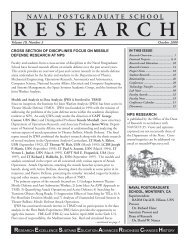Spectral Unmixing Applied to Desert Soils for the - Naval ...
Spectral Unmixing Applied to Desert Soils for the - Naval ...
Spectral Unmixing Applied to Desert Soils for the - Naval ...
Create successful ePaper yourself
Turn your PDF publications into a flip-book with our unique Google optimized e-Paper software.
sensitive a given sensor is <strong>to</strong> differences in <strong>the</strong> radiant flux being measured, respectively<br />
(Jensen, 1983). It is <strong>the</strong> spatial, spectral, temporal, and radiometric resolutions that<br />
determine <strong>the</strong> sensors overall capability in distinguishing one signal from ano<strong>the</strong>r<br />
(Jensen, 1983). In hyperspectral imagery, <strong>the</strong>se four resolution types are utilized <strong>to</strong><br />
sample surface materials using contiguous bands allowing <strong>for</strong> identification of those<br />
materials. This is done via spectral absorption features in <strong>the</strong> collected signal, or<br />
spectrum (Goetz et al., 1985). This capability is discussed in detail in <strong>the</strong> Imaging<br />
Spectrometry section.<br />
B. THE ELECTROMAGNETIC SPECTRUM<br />
Electromagnetic radiation can come from a number of sources, mostly all<br />
associated with a changing of energy state of electrons (Olsen, 2007). It travels in <strong>the</strong><br />
<strong>for</strong>m of transverse waves that result in a continuous spectrum of frequencies or<br />
wavelengths (Olsen, 1979). The electromagnetic radiation concerning us here is <strong>the</strong> kind<br />
that interacts with matter, called incident radiation (Olsen, 2007). Generation of <strong>the</strong>se<br />
electromagnetic waves occurs when energy is trans<strong>for</strong>med from kinetic, chemical,<br />
<strong>the</strong>rmal, and o<strong>the</strong>r similar sources (Elachi and Van Zyl, 2006). This electromagnetic<br />
radiation is how energy gets from some surface material <strong>to</strong> an optical sensor and is<br />
divided in<strong>to</strong> a series of spectral regions that are illustrated in Figure 2 (Elachi and Van<br />
Zyl, 2006).<br />
Figure 2. This figure from<br />
http://www.astro.cornell.edu/academics/courses/astro201/emspectrum.htm<br />
shows <strong>the</strong> divisions of <strong>the</strong> electromagnetic spectrum. The region most often<br />
exploited by remote sensing scientists range from <strong>the</strong> ultraviolet <strong>to</strong> infrared<br />
portions of <strong>the</strong> spectrum (Halvatzis, 2002, Goetz and Rowan, 1981).<br />
5
















